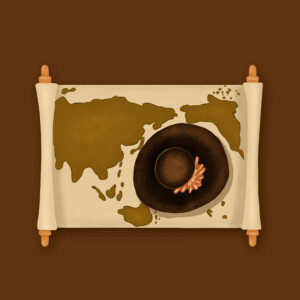
"Vermeer's Hat" by Timothy Brook is a historical book that explores the interconnected global world of the 17th century through the lens of six paintings by the Dutch artist Vermeer. Brook uses these paintings as a starting point to examine the trade networks, cultural exchanges, and societal changes that characterized the time period. The book delves into topics such as the spice trade, porcelain production, and the impact of European exploration on societies around the world. Through a series of interconnected stories, Brook brings to life the vibrant and complex world of the 17th century, showing how seemingly small objects and interactions can reveal larger historical trends and connections.
Chapter 2:the meaning of Book Vermeer's Hat"Vermeer's Hat: The Seventeenth Century and the Dawn of the Global World" by Timothy Brook is a book that explores the connections between the art of the Dutch painter Johannes Vermeer and the global trade networks of the 17th century. Through an examination of the objects depicted in Vermeer's paintings, such as a Chinese porcelain bowl or a Turkish carpet, Brook reveals how these seemingly mundane items were actually symbols of the interconnected world of trade and exchange that existed during this time period. The book sheds light on how global trade shaped the culture and society of the 17th century, and ultimately had a lasting impact on the development of the modern world.
Chapter 3:Book Vermeer's Hat chaptersChapter 1: The Author's Introduction
In this chapter, the author introduces the main themes of the book, including the interconnectedness of the world in the 17th century and the role of objects in cultural exchange. The author also discusses the importance of Johannes Vermeer's painting "Girl with a Pearl Earring" in facilitating the exploration of these themes.
Chapter 2: The Global Reach of the Delft School
This chapter explores the global connections of the Delft School of painting, highlighting the influence of Dutch trade networks on artistic production in the 17th century. The chapter also discusses the impact of global trade on the availability of luxury goods in Dutch society.
Chapter 3: The Peppered Moth and the Peppered Tree
In this chapter, the author delves into the history of the pepper trade and its impact on global trade routes. The chapter also explores the connections between the Dutch East India Company and the emergence of the scientific study of nature.
Chapter 4: Brocades and Lustring
This chapter focuses on the production and trade of luxury fabrics in the 17th century, particularly silk and satin. The author explores the global connections of the textile industry and its influence on European fashion trends.
Chapter 5: The Lacquer Screen
In this chapter, the author discusses the trade of Chinese lacquerware and its influence on European decorative arts. The chapter also explores the cultural exchange between China and Europe in the 17th century.
Chapter 6: Cartography and Cosmology
This chapter examines the role of maps in shaping European perceptions of the world in the 17th century. The author explores the connections between cartography, cosmology, and global trade networks.
Chapter 7: The Republic in the Age of the Maritime Powers
In this chapter, the author discusses the rise of the Dutch Republic as a dominant maritime power in the 17th century. The chapter explores the impact of Dutch trade networks on global commerce and cultural exchange.
Chapter 8: A Vermeer World
The final chapter of the book ties together the themes explored throughout the previous chapters, highlighting the interconnectedness of the world in the 17th century and the role of objects in facilitating cultural exchange. The author reflects on the significance of Vermeer's painting in understanding this global context.
Chapter 4: Quotes From Book Vermeer's Hat- "Objects become symbolic in ways that destabilize our easy contrasts between East and West, and provide instead a rich interconnectedness across time and space."
- "Through the clever arrangement of real objects in carefully constructed images, Vermeer laid before his viewers a vision of an interconnected and interdependent world."
- "The hat in Vermeer's painting is more than just a fashionable accessory – it is a symbol of cultural exchange and global trade."
- "Vermeer's art challenges us to reconsider our assumptions about the past and the present, and to look beyond the surface of things to uncover deeper connections."
- "The objects in Vermeer's paintings are not just physical artifacts – they are portals to a world of interconnectedness and cultural exchange."
- "Vermeer's hat is a reminder that the global economy has long been shaped by the movement of goods and people across vast distances."
- "In Vermeer's world, objects are not just things – they are also carriers of meaning and history."
- "Vermeer's paintings invite us to see the interconnectedness of the world in a new light, and to reconsider our assumptions about cultural boundaries and divisions."
- "Vermeer's hat is a powerful symbol of the global connections that have long shaped our world."
- "Through Vermeer's art, we are reminded that objects have the power to transcend time and space, and to connect us in unexpected and profound ways."
More Episodes
 2024-01-30
2024-01-30
 17
17
 2024-01-24
2024-01-24
 12
12
 2024-01-24
2024-01-24
 11
11
 2024-01-19
2024-01-19
 12
12
Create your
podcast in
minutes
- Full-featured podcast site
- Unlimited storage and bandwidth
- Comprehensive podcast stats
- Distribute to Apple Podcasts, Spotify, and more
- Make money with your podcast
It is Free
- Privacy Policy
- Cookie Policy
- Terms of Use
- Consent Preferences
- Copyright © 2015-2024 Podbean.com






